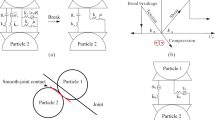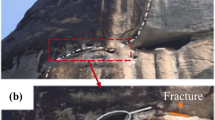Abstract
The tangential stress of surrounding rocks is large on tunnel walls. While from tunnel walls to the interior of surrounding rocks, the tangential stress declines and approaches the in situ stress in a gradient manner. To study the influences of stress gradient on the failure mechanism of rockbursts, a mesoscopic model was established based on the discrete element software particle flow code (PFC). The model was used to simulate rockburst disasters in the loading process of gradient stresses and analyze the failure modes and energy evolution process under different gradient stresses. Using the PFC platform, an acoustic emission (AE)–based simulation method at the mesoscopic scale was proposed according to the moment tensor theory to explore features of AE events, including the spatio-temporal distribution and fracture strength of the model during rockbursts. By analyzing the failure process, the increase in the applied stress gradient is found to accelerate the deterioration process of materials and promotes samples to fracture rapidly along dominant main cracks. The number of derivative cracks and the total number of cracks are significantly reduced, and the model shows a change from tensile failure to shear failure. As the applied stress gradient grows, the proportion of elastic energy storage in the model increases before a rockburst, and the rate of release of energy rises accordingly during the rockburst. The AE count at fracture points on the unloading face of the model is normally distributed with changes in the strength M, and the overall AE intensity is enhanced as the gradient increases.














Similar content being viewed by others
Data availability
The data that support the findings of this study are available from the corresponding author upon reasonable request.
References
Afraei S, Shahriar K, Madani SH (2018) Statistical assessment of rock burst potential and contributions of considered predictor variables in the task. Tunn under Sp Tech 72:250–271. https://doi.org/10.1016/j.tust.2017.10.009
Akdag S, Karakus M, Taheri A, Nguyen G, Mancha H (2018) Effects of thermal damage on strain burst mechanism for brittle rocks under true-triaxial loading conditions. Rock Mech Rock Eng 51(06):1657–1682. https://doi.org/10.1007/s00603-018-1415-3
Amad AA, Novotny AA, Guzina BB (2020) On the full-waveform inversion of seismic moment tensors. Int J Solids Struct 202:717–728. https://doi.org/10.1016/j.ijsolstr.2010.07.004
Barton N, Shen B (2018) Extension strain and rock strength limits for deep tunnels, cliffs, mountain walls and the highest mountains. Rock Mech Rock Eng 51(12):3945–3962. https://doi.org/10.1007/s00603-018-1558-2
Cao RH, Cao P, Lin H, Ma GW, Fan X, Xiong XG (2018) Mechanical behavior of an opening in a jointed rock-like specimen under uniaxial loading: experimental studies and particle mechanics approach. Arch Civ Mech Eng 18(1):198–214. https://doi.org/10.1016/j.acme.2017.06.010
Chen G, Li T, Guo F, Wang Y (2017) Brittle mechanical characteristics of hard rock exposed to moisture. B Eng Geol Environ 76(1):219–230. https://doi.org/10.1007/s10064-016-0857-7
Duan K, Li X, Kwok CY, Zhang Q, Wang L (2021) Modeling the orientation-and stress-dependent permeability of anisotropic rock with particle-based discrete element method. Int J Rock Mech Min 147:104884. https://doi.org/10.1016/j.ijrmms.2021.104884
Feng XT, Zhou YY, Jiang Q (2019) Rock mechanics contributions to recent hydroelectric developments in China. J Rock Mech Geotech 11(03):511–526. https://doi.org/10.1016/j.jrmge.2018.09.006
Ghasemi E, Gholizadeh H, Adoko AC (2020) Evaluation of rockburst occurrence and intensity in underground structures using decision tree approach. Engi Comput-Germany 36(01):213–225. https://doi.org/10.1007/s00366-018-00695-9
Gu JC, Fan JQ, Kong F, Wang KT, Xu JM, Wang T (2014) Mechanism of ejective rockburst and model testing technology. Chin J Rock Mech Eng 33(06):1081–1089. https://doi.org/10.13722/j.cnki.jrme.2014.06.002
Hradecký J, Pánek T (2008) Deep-seated gravitational slope deformations and their influence on consequent mass movements (case studies from the highest part of the Czech Carpathians). Nat Hazards 45(2):235–253. https://doi.org/10.1007/s11069-007-9157-7
Huo M, Xia Y, Liu X, Lin M, Wang Z, Zhu W (2020) Evolution characteristics of temperature fields of rockburst samples under different stress gradients. Infrared Phys Tech 109(05):103425. https://doi.org/10.1016/j.infrared.2020.103425
Jendryś M, Hadam A, Ćwiękała M (2021) Directional hydraulic fracturing (DHF) of the roof, as an element of rock burst prevention in the light of underground observations and numerical modelling. Energies 14(3):562. https://doi.org/10.3390/EN14030562
Li B, Jiang Y, Mizokami T, Ikusada K, Mitani Y (2014) Anisotropic shear behavior of closely jointed rock masses. Int J Rock Mech Min 71:258–271
Li X, Gong F, Tao M, Dong L, Du K, Ma C, Zhou Z, Yin T (2017) Failure mechanism and coupled static-dynamic loading theory in deep hard rock mining: a review. J Rock Mech Geotech 9(04):767–782. https://doi.org/10.1016/j.jrmge.2017.04.004
Li CC, Mikula P, Simser B, Hebblewhite B, Joughin W, Feng X, Xu N (2019) Discussions on rockburst and dynamic ground support in deep mines. J Rock Mech Geotech 11(05):1110–1118. https://doi.org/10.1016/j.jrmge.2019.06.001
Liu X, Xia Y, Lin M, Benzerzour M (2019) Experimental study of rockburst under true-triaxial gradient loading conditions. Geomech Eng 18(05):481–492. https://doi.org/10.12989/gae.2019.18.5.481
Liu X, Xia Y, Lin M, Wang G, Wang D (2021) Experimental study on the influence of tangential stress gradient on the energy evolution of strainburst. B Eng Geol Environ 80(06):4515–4528. https://doi.org/10.1007/s10064-021-02244-z
Lu K, Chen Y, Wang L (2021) A study on the motion and accumulation process of non-cohesive particles. Nat Hazards 105(1):205–225. https://doi.org/10.1007/s11069-020-04305-0
Luo Y, Wang G, Li X, Liu T, Mandal AK, Xu M, Xu K (2020) Analysis of energy dissipation and crack evolution law of sandstone under impact load. Int J Rock Mech Min 132(3):104359. https://doi.org/10.1016/j.ijrmms.2020.104359
Meng Q, Wang C, Huang B, Pu H, Zhang Z, Sun W, Wang J (2020) Rock energy evolution and distribution law under triaxial cyclic loading and unloading conditions. Chin J Rock Mech Eng 39(10):2047–2059. https://doi.org/10.13722/j.cnki.jrme.2020.0208
Oge IF, Cirak M (2019) Relating rock mass properties with Lugeon value using multiple regression and nonlinear tools in an underground mine site. B Eng Geol Environ 78(2):1113–1126. https://doi.org/10.1007/s10064-017-1179-0
Potyondy DO (2012) The bonded-particle model as a tool for rock mechanics research and application: current trends and future directions. Geosyst Eng 18(1):1–28. https://doi.org/10.1080/12269328.2014.998346
Potyondy DO, Cundall PA (2004) A bonded-particle model for rock. I Int J Rock Mech Min 41(8):1329–1364. https://doi.org/10.1016/j.ijrmms.2004.09.011
Roohollah SF, Abbas T (2019) Long-term prediction of rockburst hazard in deep underground openings using three robust data mining techniques. Eng Comput-Germany 35(02):659–675. https://doi.org/10.1007/s00366-018-0624-4
Si X, Huang L, Gong F, Liu X, Li X (2020) Experimental investigation on influence of loading rate on rockburst in deep circular tunnel under true-triaxial stress condition. J Cent South Univ 27(10):2914–2929. https://doi.org/10.1007/s11771-020-4518-4
Si X, Huang L, Li X, Ma C, Gong F (2021) Experimental investigation of spalling failure of D-shaped tunnel under three-dimensional high-stress conditions in hard rock. Rock Mech Rock Eng 54(06):3017–3038. https://doi.org/10.1007/s00603-020-02280-3
Song L, Wang G, Wang X, Huang M, Xu K, Han G, Liu G (2022) The influence of joint inclination and opening width on fracture characteristics of granite under triaxial compression. Int J Geomech 22(08):04022031. https://doi.org/10.1061/(ASCE)GM.1943-5622.0002372
Su G, Jiang J, Zhai S, Zhang G (2017) Influence of tunnel axis stress on strainburst: an experimental study. Rock Mech Rock Eng 50(06):1551–1567. https://doi.org/10.1007/s00603-017-1181-7
Su H, Fu Z, Gao A, Wen Z (2019) Numerical simulation of soil levee slope instability using particle-flow code method. Nat Hazards Rev 20(2):04019001. https://doi.org/10.1061/(ASCE)NH.1527-6996.0000327
Taromi M, Eftekhari A, Hamidi JK, Aalianvari A (2017) A discrepancy between observed and predicted NATM tunnel behaviors and updating: a case study of the Sabzkuh tunnel. B Eng Geol Environ 76(2):713–729. https://doi.org/10.1007/s10064-016-0862-x
Wu M, Chen Z, Zhang C (2015a) Determining the impact behavior of concrete beams through experimental testing and meso-scale simulation: I. Drop-Weight Tests Eng Fract Mech 135:94–112. https://doi.org/10.1016/j.engfracmech.2014.12.019
Wu M, Zhang C, Chen Z (2015b) Determining the impact behavior of concrete beams through experimental testing and meso-scale simulation: II. Particle element simulation and comparison. Eng Fract Mech 135:113–125. https://doi.org/10.1016/j.engfracmech.2014.12.020
Xia Y, Lin M, Liao L, Xiong W, Wang Z (2014) Fractal characteristic analysis of fragments from rockburst tests of large-diameter specimens. Chin J Rock Mech Eng 33(07):1358–1365. https://doi.org/10.13722/j.cnki.jrme.2014.07.007
Yun X, Mitri HS, Yang XL, Wang YK (2010) Experimental investigation into biaxial compressive strength of granite. Int J Rock Mech Min 47(02):334–341. https://doi.org/10.1016/j.ijrmms.2009.11.004
Zhang C, Canbulat I, Tahmasebinia F, Hebblewhite B (2017) Assessment of energy release mechanisms contributing to coal burst. Int J Min Sci Techno 27(01):43–47. https://doi.org/10.1016/j.ijmst.2016.09.029
Zhang M, Liu S, Shimada H (2018) Regional hazard prediction of rock bursts using microseismic energy attenuation tomography in deep mining. Nat Hazards 93(3):1359–1378. https://doi.org/10.1007/s11069-018-3355-3
Zhao Y, Zhao G, Zhou J, Ma J, Cai X (2021) Failure mechanism analysis of rock in particle discrete element method simulation based on moment tensors. Comput Geotech 136:104215. https://doi.org/10.1016/j.compgeo.2021.104215
Zubíček V, Hudeček V, Kubica M (2020) A proposal of rock burst control measures at the coalface No 1 4064 at the mining plant 1, in OKD. AS Czech Republic. Inzh Miner 1(01):105–112. https://doi.org/10.29227/IM-2020-01-17
Funding
This research received financial support from the National Natural Science Foundation of China (Grant No. 42002275), the Natural Science Foundation of Zhejiang province (Grant No. LQ21D020001), the Hubei Key Laboratory of Roadway Bridge and Structure Engineering (Wuhan University of Technology) (No. DQJJ202104), and the Collaborative Innovation Center for Prevention and Control of Mountain Geological Hazards of Zhejiang Province (No. PCMGH-2021–03).
Author information
Authors and Affiliations
Corresponding author
Ethics declarations
Conflict of interest
The authors declare no competing interests.
Rights and permissions
Springer Nature or its licensor (e.g. a society or other partner) holds exclusive rights to this article under a publishing agreement with the author(s) or other rightsholder(s); author self-archiving of the accepted manuscript version of this article is solely governed by the terms of such publishing agreement and applicable law.
About this article
Cite this article
Liu, X., Wang, G., Chang, Y. et al. The mesoscopic fracture mechanism of rockbursts under gradient stresses. Bull Eng Geol Environ 82, 264 (2023). https://doi.org/10.1007/s10064-023-03294-1
Received:
Accepted:
Published:
DOI: https://doi.org/10.1007/s10064-023-03294-1




